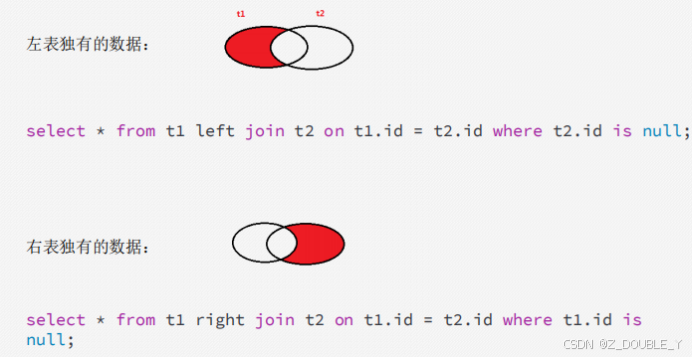目录
连接查询——left/right/inner join on
目录
连接查询——left/right/inner join on
非等值联查:
SELECT * FROM 表1,表2
等值联查:
select * from 表1,表2 where 表1.字段1=表2.字段2...
eg:5张表联查
select * from student,class,sc,course,teacher where student.classid = class.classid and student.sid = sc.sid and sc.cid = course.cid and course.tid = teacher.tid
连接查询——left/right/inner join on
语法:select * from 表1 left\right\inner 表2 on 条件
left join:从左表(表1)中返回所有的记录,即便在右(表2)中没有匹配的行。
right join:从右表(table_2)中返回所有的记录,即便在左(table_1)中没有匹配的行。
inner join:在表中至少一个匹配时,则返回记录。

eg:
所有学生的数据和对应的班级信息
-- left join on 左外联
select * from student left join class on student.classid = class.classid
-- right join on 右外联
select * from class right join student on student.classid = class.classid
连接查询——union
注意:
两个结果集的并集
去除重复行 和distinct关键字 一样
不同类型的字段是可以合并
不同列数量的结果集不允许合并
起别名给第一个结果集才有用
Eg:
获取没有班级的学生和没有学生的班级
select * from student
left join class on student.classid = class.classid
union
select * from student
right join class on student.classid = class.classid
不去重的并集——union all
select * from student
left join class on student.classid = class.classid
union all
select * from student
right join class on student.classid = class.classid
子查询(内部查询)
1、where型子查询
2、from型子查询:
把内层的查询结果当成临时表,供外层sql再次查询。查询结果集可以当成表看待。临时表要使用一个别名
3、exists型子查询:
把外层sql的结果,拿到内层sql去测试,如果内层的sql成立,则该行取出。内层查询是exists后的查询(子查询子句有结果,父句执行,子句没结果,父句不执行)
select * from teacher where exists (select * from student where classid=10);
any,some,all子查询:
any/some子查询:
表示满足其中任意一个条件
假设any内部的查询语句返回的结果个数是三个,
如:result1,result2,result3,那么,
select ...from ... where a > any(...);
->相当于:
select ...from ... where a > result1 or a > result2 or a > result3;
some 是 any的别名,所以用法是一样的,可以替代使用
Eg:
select DISTINCT student.* from sc left join student on sc.sid=student.sid where student.classid=1 and score > any //some
(select min(score) from sc left join student on sc.Sid=student.sid where student.classid=2);
all子查询:
表示满足其中所有条件条件,ALL关键字与any关键字类似,只不过上面的or改成and。
eg:
select DISTINCT student.* from sc left join student on sc.sid=student.sid where student.classid=1 and score > all
(select max(score) from sc left join student on sc.Sid=student.sid where student.classid=2);
流程控制函数,语句
结果集的控制语句
IF(expr1,expr2,expr3)
-- expr1 条件
-- exper2 条件成立 显示数据
-- exper3 条件不成立,显示数据
select * from teacher; -- 1女 -- 0男
select tid,tname,if(tsex=1,'女','男')tsex,Tbirthday,temail,Tmoney from teacher;
IFNULL(expr1,expr2)
exper1 字段
exper2 当字段为null,默认值
select sid,sname,IFNULL(birthday,"没有生日,有丢丢可怜!")birthday,ssex from student;
case when then end语句
1.简单case函数
select tid,tname,
case tsex
when 0 then '男'
when 1 then '女'
else '保密'
end tsex,Tbirthday,temail,Tmoney from teacher;
2.case搜索函数
select tid,tname,
case
when tsex<1 then '男'
when tsex=1 then '女'
when tsex>1 then '保密'
end tsex,Tbirthday,temail,Tmoney from teacher;
sql语句在数据库中的执行流程
1.系统(客户端)访问 MySQL 服务器前,做
的第一件事就是建立 TCP 连接。
2. Caches & Buffers: 查询缓存组件
3. SQL Interface: SQL接口 接收用户的SQL命
令,并且返回用户需要查询的结果。比如
SELECT ... FROM就是调用SQL Interface
MySQL支持DML(数据操作语言)、DDL
(数据定义语言)、存储过程、视图、触发器、
自定 义函数等多种SQL语言接口
4. Parser: 解析器:在解析器中对 SQL 语句进行
语法分析、语义分析。
5. Optimizer: 查询优化器
6.存储引擎
7.文件系统
8.日志系统
sql查询语句的执行顺序
手写:select distinct from where group by having order by
机读:from on where group by having select distinct order by
